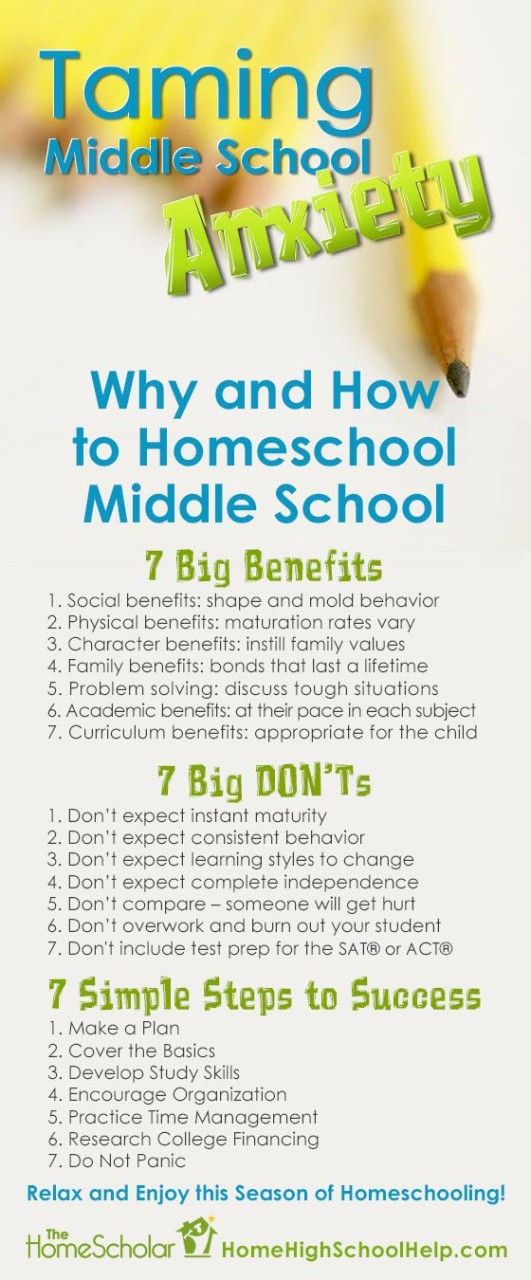7 Simple Steps to a Middle School Homeschool Plan
It can be a temptation to totally panic when you start planning middle school homeschool for the first time. You may like my article, Taming Middle School Anxiety. But right now, let me give you 7 easy steps to assist you in your planning.
1. Make a plan for your classes
That way you'll be sure to have all the courses you need for college and career success. You will find it helpful to plan your middle school and high school courses before they arrive. A rough draft with a five-or-six year plan can eliminate some of the "Oh, no! High school!" panic I sometimes see in parents. Develop a plan that will include English, math, science, and social studies each year. Consider introducing a foreign language in middle school, so you can ease into it, allowing for plenty of time to get the two to three years of foreign language many colleges require.
2. Emphasize the basics
Literacy covers a multitude of challenges, so keep classes challenging, but not overwhelming. Your child will need to know how to read fluently and write understandably. They will need to understand key math concepts, so they can build on those skills in high school. Encourage the love of learning with delight directed activities when possible. Reading, writing, math, and attitude are the four cornerstones of study skills.
3. Develop study skills
Help your student buckle down and do the toughest classes first and the fun stuff second. Teach your child to complete assignments when directed and to take a test calmly, without anxiety, for optimal performance. Provide assignments so your student can complete work on their own while learning time management one day at a time at first. Later, give assignments one whole week at a time. Much later in high school, your child will be ready for long term assignments, perhaps one month at a time.
4. Encourage organization
Help them learn how to become organized as they learn to prioritize their work. Provide an organized study space, with necessary tools at hand. Have a place to keep papers – perhaps a notebook for each subject. Encourage your child to work with a schedule or assignment list and to use a calendar for assignments. When they have a regular time, place, and procedure for studying, your child is more likely to take those habits with them after high school. Explain how to manage their assignments. It often works to do the "worst first" - the most difficult or least enjoyable subjects first. It also helps to break big projects into smaller steps. Estimate time for each step.
5. Practice time management
Truthfully, this takes years and YEARS of work, and starting early can really help—just don't expect perfection. Help your child to understand time commitments to make sure expectations are reasonable while they balance school and friends. Encourage your child to take regular breaks. I suggest about 30 to 50 minutes of study, with at least 10-minute breaks. This is even more important for active learners, young men, and athletes. Regular exercise breaks, especially strenuous activities, can help teenagers manage hormones. Remind your child that daily study is most effective. Avoid letting them cram for tests or writing papers, as can sometimes happen in co-op and classroom settings.
6. Think about college financing
Consider how you will save for college, and how you can position your student for scholarships based on their unique skills and abilities. College financing can be confusing, so spend time investigating options well in advance. Although earlier is easier, it's not too late to begin saving for college. Research the College 529 Plan. Learn about the different investment plans available, and try to start setting money aside now. Estimate the financial aid you might receive from colleges, using the FAFSA® forecaster at studentaid.gov/aid-estimator.
7. Don't panic!
You have 2-3 full years of middle school homeschool before your child should begin high school classes. Take it easy! It doesn't need to be so hard! Focus on learning and you can't go wrong. When you genuinely care about your child's education, you are taking the necessary steps for high school. A variety of different homeschool methods can be successful. You don't have to change your method of homeschooling when you are thinking about high school or college. Instead, focus on learning on purpose each day. When your child is in middle school, you can't be behind. Do your best to educate your child and you won't go wrong!
5 Fabulous Finds for parents planning for middle school:
1. Read Taming Middle School Anxiety to calm your concerns.
2. Read 7 Ways to Encourage Reading in Middle School.
3. Sign up for a FREE recorded class "12 Keys to High School Success."
4. Read the coordinating Coffee Break Book: Homeschooling Middle School with Powerful Purpose.
5. Read about the High School Solution for the best preparation for young teens.
The High School Solution will help a homeschool parent like you! You can homeschool middle school and high school with confidence and excellence. Homeschooling high school can seem a daunting challenge to even the most seasoned homeschool parent. It's a great help to parents that homeschool in all sorts of ways, giving you the training you need to become your child's best teacher and guidance counselor. You can continue homeschooling independently, even in the upper grades.
When you subscribe to the blog, we will send you an e-mail when there are new updates on the site so you wouldn't miss them.

 Login
Login










.jpg)

Comments